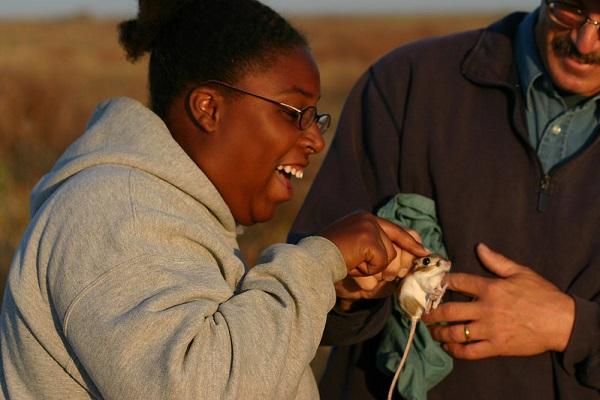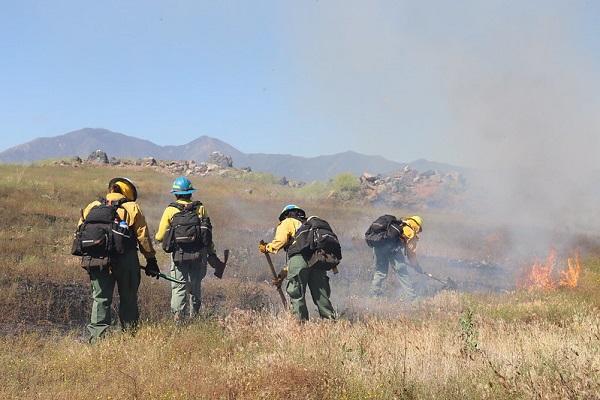You are viewing ARCHIVED content published online before January 20, 2025. Please note that this content is NOT UPDATED, and links may not work. Additionally, any previously issued diversity, equity, inclusion or gender-related guidance on this webpage should be considered rescinded. For current information, visit https://www.blm.gov/blog.
One hop closer to recovery for the Stephens’ kangaroo rat
Story by Kate Miyamoto, Public Affairs Specialist, California Desert District. Photos by Stephen Laymon, BLM; and James Gannon, BLM.
More than 30 years of conservation efforts by federal, state, and local partners paid off for the Stephens’ kangaroo rat (Dipodomys stephensi), a small, nocturnal rodent that hops to move, with oversized hind legs like a kangaroo, a long tail, and the ability to ricochet sideways, backwards, and launch several feet in the air to elude predators. This past February, the U.S. Fish and Wildlife Service removed the Stephens’ kangaroo rat from the endangered species list, reclassifying it to threatened. This down-listing was achieved in large part due to the BLM’s and its partners’ collaborative habitat management efforts on the ground.

"We now have our second species (the first being the San Benito Evening Primrose) that has an [ESA] listing change this year,” says Amy Fesnock, BLM Resource Advisor in the California Desert District. “BLM staff did a fantastic job staying focused on recovery actions, amidst the pull of BLM's everyday business."
The Stephens’ kangaroo rat lives in areas with sandy soil in sparsely vegetated grassland. Their habitat is confined to about 1,100 square miles in southern California, but their geographic range spans from western Riverside County to northern San Diego County, crossing several county lines and jurisdictions. In 1988, the Stephens’ kangaroo rat was listed as endangered mostly due to habitat loss.
The conservation efforts to achieve this down-listing started in 1990, when the Riverside County Habitat Conservation Agency, comprised of Riverside County and cities in southern California, was formed to develop a habitat conservation plan, acquire land, and manage habitat for the Stephens’ kangaroo rat.
In 1996, a long-term habitat conservation plan was completed covering 30,000 acres of Stephens’ kangaroo rat habitat. The long-term plan established seven reserves, expanded the reserves through BLM exchange lands, and guided management of the reserves.
Work on the ground started in 2008, when the BLM and Riverside County Habitat Conservation Agency began habitat management efforts, which included improving the Stephens’ kangaroo habitat through prescribed fire. BLM fuels staff worked with Riverside County Habitat Conservation Agency to complete prescribed burns and other fuels treatments on approximately 3,500 acres to remove non-native grasses, which were limiting the rats’ eating and breeding. Treatments occur on a rotational basis to maintain optimal Stephens’ kangaroo rat habitat.

In 2018, the BLM partnered with the Department of Defense through the Recovery and Sustainment Partnership Initiative, which identifies listed species on BLM-managed land and military reservations and helps move the species toward recovery. The Stephens’ kangaroo rats’ habitat is found on four military reservations in San Diego County and impacts the Department of Defense’s training operations.
Under the Good Neighbor Authority, the BLM and Department of Defense contracted with the Riverside County Habitat Conservation Agency to develop management actions such as a Range-wide Management and Monitoring Plan; plan and implement monitoring and DNA sampling; manage habitat; manage invasive plants; assess and manage unauthorized activities; and complete outreach and education. BLM fuels staff initiated the contract with support from Amy Fesnock, BLM Resource Advisor in the California Desert District.
The most important action was to develop the Range-wide Management and Monitoring Plan - a unified blueprint for management and monitoring of the species. To develop the plan, BLM partnered with the Riverside County Habitat Conservation Agency, U.S. Fish and Wildlife Service, the U.S. Geological Survey, California Department of Fish and Wildlife, Department of Navy, the Conservation Biology Institute, researchers, landowners, and other stakeholders. When fully implemented, the plan will facilitate a focused effort to protect Stephens’ kangaroo rat and its habitat, unify more than 30 agencies and organizations involved in the conservation of the species, and provide a process to measure recovery.
A partnership was also established with the San Diego Zoo Wildlife Alliance to develop genetic sampling protocols. Surveys for the Stephens’ kangaroo rat have been and continue to be completed at established monitoring areas.
The BLM, Riverside County Habitat Conservation Agency, and other partners continue to work together to restore and protect habitat for the Stephens’ kangaroo rat. The threat of habitat loss for Stephens’ kangaroo rat has been reduced due to the development of two habitat conservation plans, the coordinated efforts and support of Department of Defense, and the implementation of management actions under the Good Neighbor Authority. This down-listing provides flexibility for landowners in the species’ range to conduct weed and fire management actives and other beneficial actions.
James Gannon, Fuels Program Manager, points out: “This [down-listing of the Stephens’ kangaroo rat] couldn’t have been done without the cooperation of many agencies and organizations and the willingness of staff to work together to achieve a common goal.”
It took more than 30 years and more than 30 agencies and organizations to achieve this monumental milestone for the Stephens’ kangaroo rat. But the work doesn’t stop. The BLM and others continue forward, one hop at a time, toward a goal of recovering the species to achieve delisting from the Endangered Species Act.
Related Stories
- BLM recreation sites available to all: Exploring accessibility on California’s public lands
- BLM California partners to secure America’s border
- Meet the Engineers: BLM California celebrates 2025 National Engineers Week by getting to know some of our finest!
- Honoring Excellence in Service: Ranger Perez Recognized as BLM California Ranger of the Year
- Exploring the Campbell Tract Special Recreation Management Area: Flora, fauna, and volunteer opportunities
